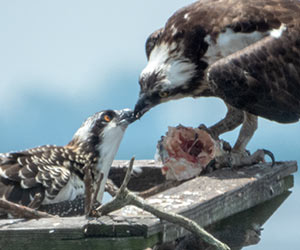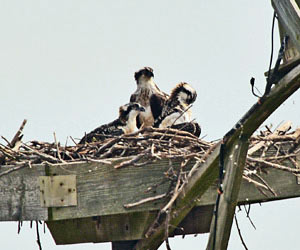Osprey Facts
General description: An osprey is a large bird with a length of 22-25 inches, a wingspan of 4.5-6 feet, and a weight of approximately 4 pounds. The osprey has a dark brown back and a white belly, as well as a white head, which features a dark stripe running from its yellow eyes to the back of its head. Female ospreys are slightly larger than males and may sport a dark speckled necklace. Ospreys are seen in the Chesapeake Bay area from spring through fall, but are rare in the winter. North American ospreys winter in Florida, the Caribbean, on the Gulf Coast, and in South America.
Eating behavior: The osprey dines almost exclusively on live fish, often catching its meals by hovering over the water at an altitude of 50 to 200 feet, then diving feetfirst into the water to catch its prey. The osprey's feet are uniquely adapted to "air fishing." Each osprey foot has a reversible front toe, as well as barbs (called spicules), which help it hold onto a slippery fish in flight. Normally an osprey will aerodynamically position a fish headfirst in its talons before it returns to the nest.
Nesting behavior: Like bald eagles, ospreys often reuse old nests, adding new material to them each season. Ospreys prefer nests near water, especially in large trees, but will also nest on artificial platforms. Ospreys 3 years or older usually mate for life, and their spring courtship begins a 5-month period when they raise their young.
By around the end of April, the female osprey usually lays 2 to 4 eggs, about 3 days apart and each about the size of a large chicken egg with coloring of white to light brown splashed with varying shades of red, brown, and gray blotches. The eggs will hatch in the same sequence as they were laid, in about 4 to 5 weeks time. The female will stay on the nest the majority of the time, with the male giving her an occasional break when she leaves to hunt for food. Within 30 days of hatching, the young birds will be 70-75% of their adult weight. The chicks will fledge about 55 days after hatching but will use the nest as home base until they migrate in September. Young ospreys will stay dependent on their parents until the young are able to fish for themselves. The female adult usually migrates first, while the male adult remains behind to help the young with fishing. The male will migrate about the same time as the young, which is a few weeks after the mother, depending on the chicks' development.
Threats: Like many birds of prey, the osprey suffered during the 60s and 70s due to the rampant use of DDT and other dangerous pesticides. Research done at Maryland's Patuxent Research Refuge was used in Rachel Carson's classic "Silent Spring," and alerted citizens, scientists, and politicians to the fact that DDT was harming bird populations. Patuxent's scientists discovered that DDT was working its way up the food chain and thinning the eggshells of raptors. Fortunately, DDT was banned in the U.S. in 1972, and thanks to the hard work of many dedicated people, birds of prey are beginning to rebound.
Other interesting osprey facts from Alan Poole's "Ospreys: A Natural and Unnatural History" (Cambridge University Press, 1989):
- ospreys generally pair for life, but if mating is unsuccessful, will sometimes "divorce"
- a female osprey will choose her mating partner based on the quality and location of the male's nest
- osprey nests have been known to contain hula hoops, rag dolls, toy boats, and fishing line, which can be dangerous to the birds
- osprey parents will sometimes hold back food in order to encourage fledglings to leave the nest
- osprey fledglings will sometimes visit nearby nests where they are fed by other parents
Other Osprey Websites
- Osprey: Information form the Chesapeake Bay Program about ospreys.
- All About Birds - Osprey
- Osprey Watch
- Osprey Trax
- International Osprey Foundation
Return to the Blackwater NWR Osprey Cam or the Cam Central page.


